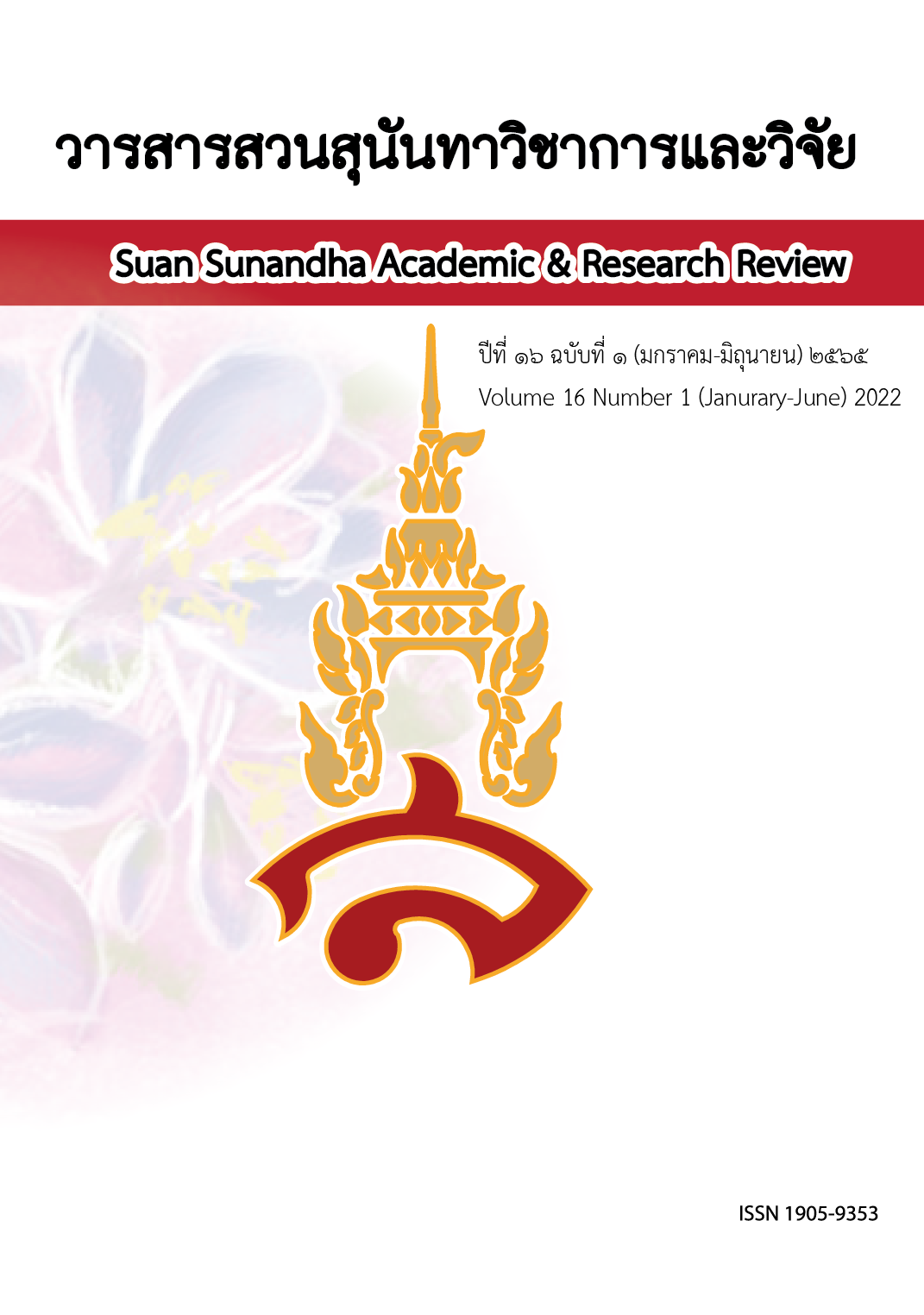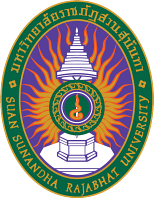การบริหารจัดการแหล่งท่องเที่ยวสนับสนุนการสร้างธุรกิจไมซ์เมืองรอง หลักฐานจากมุมมองผู้มีส่วนได้เสียจังหวัดนครนายก
คำสำคัญ:
การท่องเที่ยวไมซ์, ธุรกิจไมซ์เมืองรอง, ปัจจัยความสำเร็จธุรกิจไมซ์, จังหวัดนครนายกบทคัดย่อ
การวิจัยศึกษาถึงองค์ประกอบที่มีอิทธิพลต่อความสำเร็จในการที่จะสร้างธุรกิจไมซ์ในพื้นที่เมืองรองจังหวัดนครนายก และศึกษาถึงอิทธิพลของระดับการรับรู้เกี่ยวกับองค์ประกอบด้านเครือข่ายชุมชน ความผูกพันต่อพื้นที่ สังคม เศรษฐกิจ วัฒนธรรม ที่ส่งผ่านการรับรู้เกี่ยวกับการมีส่วนร่วมของชุมชน และแนวปฏิบัติของผู้ประกอบการ ไปสู่ความเป็นไปได้ที่จะประสบความสำเร็จในการสร้างธุรกิจไมซ์ในพื้นที่จังหวัดนครนายก วิธีการวิจัยแบบผสมผสานมีวิธีการวิจัยทั้งเชิงปริมาณและเชิงคุณภาพ โดยการวิจัยเชิงปริมาณสำรวจข้อมูลด้วยแบบสอบถาม ประมวลผลโดยใช้โปรแกรมสำเร็จรูปทางสถิติ เพื่อยืนยันตัวแบบสมการโครงสร้างขณะที่การวิจัยเชิงคุณภาพสัมภาษณ์มีส่วนได้เสียที่เกี่ยวข้องในอุตสาหกรรมไมซ์ แล้วทำการวิเคราะห์เนื้อหา เพื่อสร้างข้อสรุป ผลการวิจัยพบว่าอิทธิพลรวม ปัจจัย สังคม เศรษฐกิจ วัฒนธรรมมีอิทธิพลต่อความเป็นไปได้ที่จะประสบความสำเร็จในการสร้างธุรกิจไมซ์เท่ากับ 0.362. ส่วนปัจจัยคั่นกลาง คือ ปัจจัยแนวปฏิบัติของผู้ประกอบการมีอิทธิพลเชิงลบต่อปัจจัยความเป็นไปได้ที่จะประสบความสำเร็จในการสร้างธุรกิจไมซ์ในพื้นที่ ในขณะที่ปัจจัยการมีส่วนร่วมของชุมชนมีอิทธิพลเชิงบวก ในส่วนของการวิจัยเชิงคุณภาพ พบว่า ผู้มีส่วนเกี่ยวข้องทุกฝ่ายมีทัศนคติเชิงบวกต่อจังหวัดนครนายกว่านครนายกยังคงเป็นจังหวัดที่มีศักยภาพสูงด้านการท่องเที่ยวเนื่องด้วยความสมบูรณ์ของทรัพยากร ผู้มีส่วนได้เสียมีความคิดเห็นว่าการพัฒนาเพื่อรองรับการท่องเที่ยวแนวใหม่โดยเฉพาะในรูปแบบที่รองรับต่างชาติ ยังคงต้องอาศัยการพัฒนาต่อไปในระยะยาว จากผลการวิจัยที่ได้นำเสนอข้างต้นเป็นที่ประจักษ์ว่าอุตสาหกรรมการไมซ์ในพื้นที่เมืองรองนั้นสามาถเกิดขึ้นได้ด้วยการสนับสนุนจากปัจจัยทั้งในส่วนโครงสร้างทางกายภาพของแหล่งท่องเที่ยว และการมีส่วนร่วมของผู้มีส่วนได้เสียเป็นสำคัญ อย่างไรก็ตามส่วนของแนวปฏิบัติของผู้ประกอบการความผูกพันต่อพื้นที่นั้นเป็นปัจจัยที่ต้องขับเคลื่อนโดยอาศัยอิทธิพลร่วมจากปัจจัยอื่นร่วม
เอกสารอ้างอิง
Buzinde, C. N., Kalavar, J. M., & Melubo, K. (2014). Tourism and community welling: The case of the Maasai in Tanzania. Annals of Tourism Research, 44, 20-33.
Byrne, B. (1998). Structural Equation Modeling with LISREL, PRELIS and SIMPLIS: Basic Concepts, Applications and Programming. Mahwah. New Jersey: Lawrence Erlbaum Associates.
Davidson, R., Alford, P., & Seaton, T. (2002). The use of information and communications technology by the European meetings, incentives, conferences, and exhibitions (MICE) sectors. In Journal of Convention & Exhibition Management, 4, pp. 17-35.
Diamantopoulos, A., & Siguaw, J. A. (2000). Introducing LISREL. London: Sage Publications.
Diedrich, A., & García-Buades, E. (2009). Local perception of tourism as indicators of destination declines. Annals of Tourism Research, 36(4), 41-63.
Hankinson, G. (2005). Destination brand image: a business tourism perspective. Journal of Service Marketing, 19(1), 24-32.
Hu, L. T., & Bentler, P. M. (1999). Cutoff Criteria for Fit Indexes in Covariance Structure Analysis: Conventional Criteria Versus New Alternatives. Structural Equation Modeling, 6(1), 1-55.
MacCallum, R. C., Browne, M. W., & Sugawara, H. M. (1996). Power Analysis and Determination of Sample Size for Covariance Structure Modeling. Psychological Methods, 1(2), 130-149.
Miles, J., & Shevlin, M. (1998). Effects of sample size, model specification and factor loadings on the GFI in confirmatory factor analysis. Personality and Individual Differences, 25, 85-90.
Moyo, S., & Tichawa, T. (2017). Community involvement and participation in tourism development: a Zimbubwe study tourism review International 21. African Journal of hospitality Tourism and Leisure, 6(1).
Ratajczak-Mrozek, M. I. (2014). Cooperation, Innovations and Knowledge in MICE Tourist Product Perception. Journal of Convention Exhibition Management, 5(2), 41-50.
Schermelleh-Engel, K. M. (2003). Evaluating the fit of structural equation models: Tests of significance and descriptive goodness-of-fit measures. Methods of Psychological Research Online, 8(2), 23-74.
Sharma, S., Mukherjee, S., Kumar, A., & Dillon, W. R. (2005). A simulation study to investigate the use of cutoff values for assessing model fit in covariance structure models. Journal of Business Research, 58(1), 935-943.
Slaper, T. F., & Hall, T. J. (2011). The triple bottom line: What is it and how does it work. Indiana Business Review, 86(1), 4-8.
Stanton, J. M. (2001). Galton, Pearson, and the peas: A brief history of linear regression for statistics instructors. Journal of Statistics Education, 9(3).
Sumithra, D., & Mishra, J. M. (2016). Efficacy of mice tourism industry and supply chain management as an integrated approach. International Journal of Management Research and Reviews, 6(7), 894-903.
Thailand Convention & Exhibition Bureau (Public Organization). (2018). MICE Business Overview: Meetings, Exhibitions Reward Travel. Bangkok: Thailand Convention & Exhibition Bureau (Public Organization) (In Thai).
Vandenberg, R. J. (2006). Statistical and Methodological Myths and Urban Legends. Organizational Research Methods, 9(2), 194-201.
Westland, J. C. (2010). Lower bounds on sample size in structural equation modeling. Electronic. Commerce Research and Applications, 9(6), 476-487.
Wheaton, B., Muthen, B., Alwin, D. F., & Summers, G. (1977). Assessing Reliability and Stability in Panel Models. Sociological Methodology, 8(1), 84-136.
ดาวน์โหลด
เผยแพร่แล้ว
รูปแบบการอ้างอิง
ฉบับ
ประเภทบทความ
สัญญาอนุญาต
ลิขสิทธิ์ (c) 2022 สถาบันวิจัยและพัฒนา มหาวิทยาลัยราชภัฎสวนสุนันทา

อนุญาตภายใต้เงื่อนไข Creative Commons Attribution-NonCommercial-NoDerivatives 4.0 International License.
บทความที่ได้รับการตีพิมพ์เป็นลิขสิทธิ์ของ สถาบันวิจัยและพัฒนา มหาวิทยาลัยราชภัฎสวนสุนันทา
ข้อความที่ปรากฏในบทความแต่ละเรื่องในวารสารวิชาการเล่มนี้เป็นความคิดเห็นส่วนตัวของผู้เขียนแต่ละท่านไม่เกี่ยวข้องกับมหาวิทยาลัยราชภัฎสวนสุนันทา และคณาจารย์ท่านอื่นๆในมหาวิทยาลัยฯ แต่อย่างใด ความรับผิดชอบองค์ประกอบทั้งหมดของบทความแต่ละเรื่องเป็นของผู้เขียนแต่ละท่าน หากมีความผิดพลาดใดๆ ผู้เขียนแต่ละท่านจะรับผิดชอบบทความของตนเองแต่ผู้เดียว






